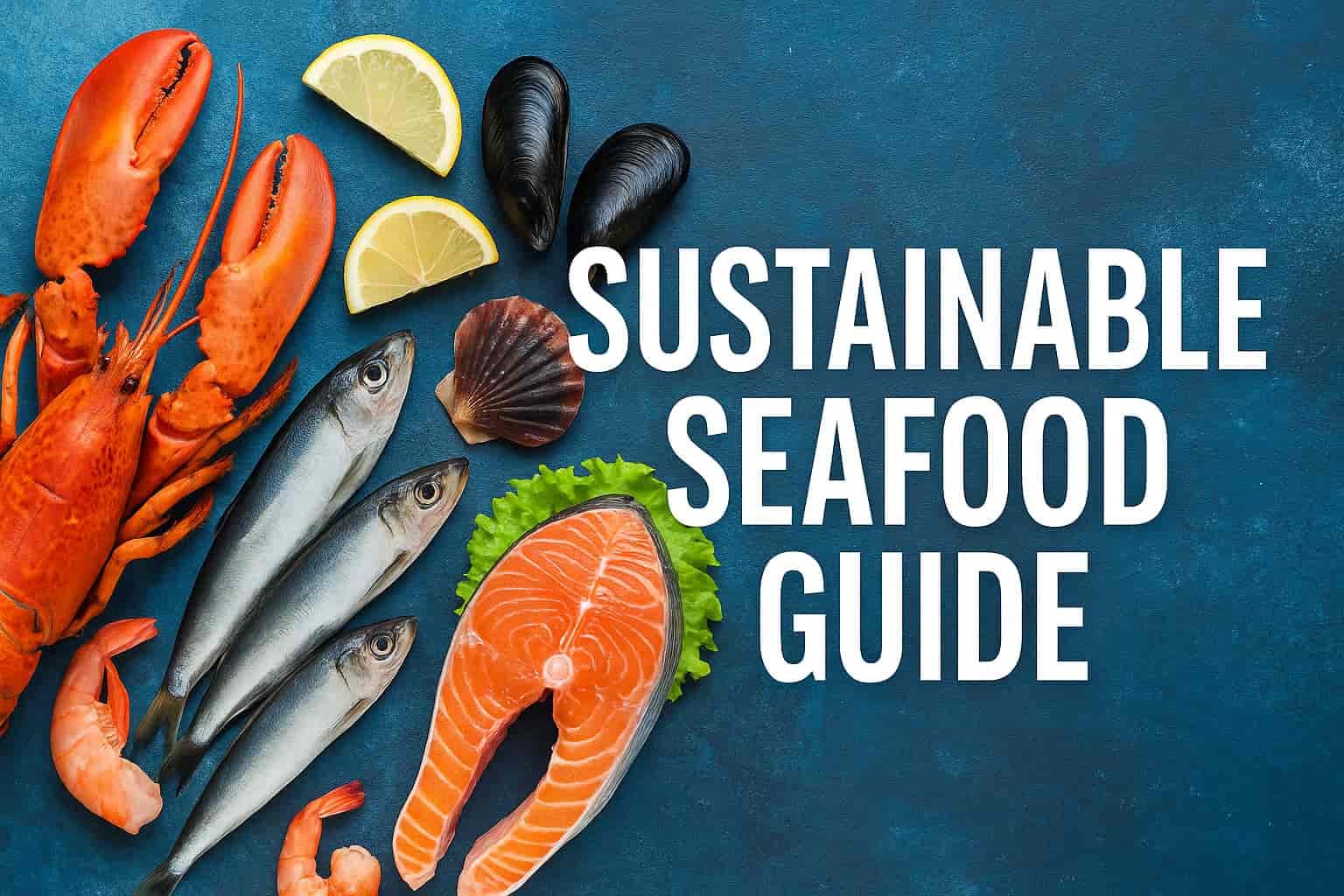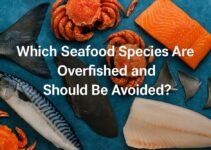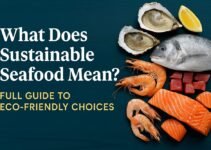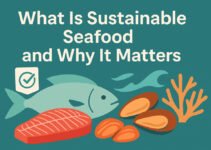Sustainable seafood is no longer a trendy buzzword; it is a critical consumer responsibility. According to the Food and Agriculture Organization (FAO), over 34% of the world’s fish stocks are overfished, putting marine ecosystems under severe stress. Choosing sustainable seafood directly supports healthier oceans, preserves endangered species, and ensures future generations can enjoy the nutritional benefits of seafood.
As a conscious consumer, your choices matter. Sustainable seafood is not only healthier for the environment but also safer for your health, often containing lower levels of contaminants like mercury and microplastics. This guide will help you identify sustainable seafood options, understand the risks of overfishing, and make informed purchasing decisions at markets and restaurants. Whether you are a home cook or a seafood enthusiast, this practical guide empowers you to eat responsibly without sacrificing taste or nutrition.
Contents
- 1 What Does Sustainable Seafood Mean in Practical Terms?
- 2 Why Is Overfishing a Critical Global Concern?
- 3 Which Seafood Species Are Considered the Most Sustainable Choices?
- 4 How Can You Identify Sustainable Seafood at the Market?
- 5 What Are the Risks of Consuming Non-Sustainable Seafood?
- 6 How Can You Support Sustainable Fishing Practices as a Consumer?
- 7 What Are the Best Cooking Methods to Preserve the Nutritional Value of Sustainable Seafood?
- 8 Where Can You Find Reliable Suppliers of Sustainable Seafood?
What Does Sustainable Seafood Mean in Practical Terms?
Sustainable seafood refers to fish and shellfish caught or farmed in ways that ensure the long-term health of marine ecosystems and fish populations.
How Is Sustainability Measured in the Seafood Industry?
Sustainability in seafood is measured using three core criteria: stock health, environmental impact, and effective management.
- Stock Health: Fish populations must be abundant and resilient. For example, the Alaskan salmon fishery operates under strict quotas, keeping stock levels healthy.
- Environmental Impact: Fishing methods should minimize bycatch and habitat damage. Purse seine nets, which target specific schools of fish, are more sustainable than bottom trawling.
- Management Practices: Sustainable fisheries follow science-based regulations. The Marine Stewardship Council (MSC) evaluates fisheries on 28 performance indicators covering these criteria.
What Are the Key Certifications for Sustainable Seafood?
There are five globally recognized certifications for sustainable seafood:
- Marine Stewardship Council (MSC) – Focuses on wild-caught seafood sustainability.
- Aquaculture Stewardship Council (ASC) – Covers responsibly farmed seafood.
- Best Aquaculture Practices (BAP) – Certifies farmed seafood based on environmental and social responsibility.
- Friends of the Sea – Certifies both wild and farmed sustainable seafood.
- Global Aquaculture Alliance (GAA) – Provides certification through the BAP program.
Why Is Overfishing a Critical Global Concern?
Overfishing depletes fish populations faster than they can reproduce, leading to the collapse of marine species and ecosystems.
Which Fish Species Are Most Affected by Overfishing?
Five major fish species face critical threats from overfishing:
- Atlantic Bluefin Tuna – Population reduced by over 85% since the 1970s.
- Orange Roughy – A deep-sea species with a lifespan over 100 years but slow reproduction rates.
- Sharks (Various Species) – Over 100 million sharks are killed yearly, mainly for their fins.
- Pacific Sardines – Once abundant, now experiencing sharp population declines.
- European Eel – Classified as critically endangered due to habitat loss and overfishing.
How Does Overfishing Disrupt Marine Ecosystems?
Overfishing causes imbalances in marine food chains, leading to the collapse of predator and prey species alike.
- Removing apex predators like sharks results in an overpopulation of smaller species, destabilizing the ecosystem.
- Destructive fishing methods such as trawling damage coral reefs, which are habitats for over 25% of marine life.
- Coastal communities dependent on fishing face economic hardship as fish stocks disappear.
Which Seafood Species Are Considered the Most Sustainable Choices?
Sustainable seafood species are those harvested or farmed with minimal environmental impact and in compliance with strict management practices.
What Are the Top 5 Sustainably Farmed Fish?
The following five fish species are recognized as the most sustainable farmed options:
- Atlantic Salmon (ASC Certified) – Raised in closed containment systems to prevent pollution and disease spread.
- Barramundi (BAP Certified) – Efficient feed conversion rate and low environmental footprint.
- Rainbow Trout (ASC and BAP Certified) – Farmed using freshwater recirculating systems that minimize waste.
- Tilapia (Global GAP Certified) – Herbivorous diet reduces dependency on wild fishmeal.
- Catfish (BAP Certified) – Raised in controlled aquaculture environments with rigorous water quality management.
Which Shellfish Have the Lowest Environmental Impact?
Four shellfish species consistently rank as the most environmentally friendly choices:
- Mussels – Require no feed; they filter and clean the water naturally.
- Oysters – Improve coastal water quality by filtering up to 50 gallons of water per day per oyster.
- Clams – Sustainably harvested with minimal habitat disruption.
- Scallops (Diver-Caught) – Hand-collected methods prevent seabed damage.
How Can You Identify Sustainable Seafood at the Market?
To identify sustainable seafood, check for recognized eco-labels, verify catch or farm origin, and understand product labels.
What Are the Reliable Eco-Labels and Certifications to Look For?
Five certifications guarantee sustainable seafood practices:
- Marine Stewardship Council (MSC)
- Aquaculture Stewardship Council (ASC)
- Best Aquaculture Practices (BAP)
- Friends of the Sea (FOS)
- Global GAP
How Do You Read and Understand Seafood Labels Correctly?
Seafood labels provide critical information about the product’s origin and sustainability status. Focus on these four details:
- Country of Origin: Prefer products from countries with strict sustainability regulations like Norway, Canada, and New Zealand.
- Catch Method: Select products labeled as “pole-and-line caught” or “hand-dived.”
- Farming Practices: Look for designations such as “recirculating aquaculture systems.”
- Certification Marks: Confirm the presence of recognized sustainability logos before purchase.
What Are the Risks of Consuming Non-Sustainable Seafood?
Non-sustainable seafood increases the risk of environmental damage and personal health hazards due to higher contamination levels.
How Does Unsustainable Fishing Contribute to Mercury and Toxin Accumulation?
Unsustainable fishing often targets large predatory fish that accumulate higher levels of mercury and toxins.
- Species like Swordfish, King Mackerel, and Shark contain mercury levels exceeding 0.5 ppm.
- Industrial pollution in overfished areas leads to increased contamination of PCBs and dioxins.
- Consuming these contaminated species raises risks of neurological damage and developmental disorders.
Are There Health Risks Tied to Farmed Fish from Unsustainable Sources?
Fish from poorly managed farms often contain higher antibiotic residues, pollutants, and disease risks.
- Up to 90% of farmed salmon from non-certified sources contain elevated levels of harmful chemicals.
- Antibiotic overuse leads to antibiotic-resistant bacteria, posing public health risks.
- Farmed fish in open net pens frequently escape and introduce diseases to wild populations.
How Can You Support Sustainable Fishing Practices as a Consumer?
You can support sustainable fishing practices by making responsible purchasing decisions, advocating for stronger regulations, and reducing personal seafood waste.
Should You Prefer Wild-Caught or Farm-Raised Seafood?
The choice depends on the species and certification; both can be sustainable if sourced responsibly.
- Wild-Caught Seafood: Choose MSC-certified options like Alaskan wild salmon.
- Farm-Raised Seafood: Prioritize ASC or BAP-certified products. Farmed mussels and oysters are excellent low-impact options.
How Does Your Seafood Consumption Influence Global Fisheries?
Consumer demand directly shapes fishing practices and industry supply chains.
- Each purchase of certified sustainable seafood reinforces responsible fishing practices.
- High demand for overfished species encourages illegal, unregulated fishing operations.
- Opting for sustainable alternatives helps stabilize marine ecosystems.
What Are the Best Cooking Methods to Preserve the Nutritional Value of Sustainable Seafood?
Steaming, baking, and grilling are the top three cooking methods that retain the most nutrients in seafood.
Which Cooking Techniques Retain Omega-3 Fatty Acids Best?
Steaming and baking at moderate temperatures preserve Omega-3 fatty acids most effectively.
- Steaming retains up to 95% of Omega-3s.
- Baking under 180°C maintains essential fatty acids.
- Avoid deep-frying, which degrades Omega-3s.
How Can You Avoid Common Mistakes That Reduce Seafood Quality?
Follow these four best practices:
- Avoid overcooking; cook until internal temperatures reach 63°C (145°F).
- Minimize added fats; use healthy oils sparingly.
- Use fresh ingredients to preserve nutrients.
- Don’t rinse after cooking to retain flavors and nutrients.
Where Can You Find Reliable Suppliers of Sustainable Seafood?
Reliable suppliers are certified by recognized sustainability organizations and maintain transparent sourcing practices.
Are Online Seafood Markets a Trustworthy Source for Sustainable Options?
Yes, several reputable online seafood markets specialize in certified sustainable products:
- Vital Choice Seafood
- Sea to Table
- Wild Alaskan Company
How to Choose the Best Local Seafood Markets and Vendors?
Look for vendors who provide transparent sourcing information and display certification labels.
- Ask about origin, fishing methods, and certifications.
- Prefer markets offering seasonal, local seafood options.
- Avoid vendors who cannot clearly answer questions about sourcing.
By making informed choices, you contribute directly to preserving marine biodiversity and supporting ethical fishing communities. Whether selecting certified sustainable products at the market or choosing responsibly sourced dishes at a restaurant, your actions influence global seafood demand. Explore more about Is it Safe to Eat Raw Shellfish and Sushi? to make even more informed decisions about your seafood consumption.



